#Astronomical Spectroscopy
Explore tagged Tumblr posts
Text
just took some delightful midnight adderall so I can finish my finals week shit before it's due in. uh. 11 hours, 1 minute. and I'm thinking about how my advisor keeps shit talking theoreticians and computational astrophysicists but in the politest, most british ways possible
#'well do we really /know/ anything from simulations?' (<- after I said that almost all of what we know about the physical properties of#galaxies comes from observations & spectroscopy and she was deciding if she wanted me to reword that or not)#karen I imagine several people would have a bounty on your head for saying that out loud#I'm still not over her saying that [cosmology prof] was invited to the summer astro talks because 'we can pretend that he's an astronomer'#when my dad picked me up at the airport he said he was 'impressed' by my 2:29am text message to him because it would have been#3:29am for me when I sent it and immediately shot down my suggestion that I'd just schedule sent it#told my mom I'd be passing the fuck out as soon as I've submitted everything and she's probably not seeing me until saturday afternoon#subtitle of this semester is 'don't think too hard about my message timestamps :) it's okay :)'
3 notes
·
View notes
Text

By Allie Yang
10 August 2023
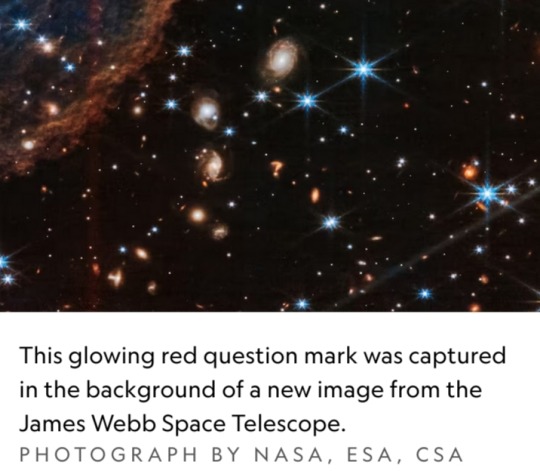
Two of our galaxy’s most famous stars were recently photobombed by what appears to be a celestial question mark.
The symbol was spotted in a new image from the James Webb Space Telescope (JWST) of the forming stars Herbig-Haro 46/47, which are well-known and have been frequently observed by astronomers.
These two stars can provide clues about how our own sun may have formed.
They’re relatively close to Earth, about 1,400 light-years, and relatively young, only a few thousand years old.
In fact, they’re still in gestation and have not technically been “born” yet, which is marked when the stars start shining from their own nuclear fusion.
The image is the first of the twin protostars from the NIRCam instrument on JWST.
It was captured using infrared light, which penetrates space dust more easily than visual light, and it is the highest resolution image of the objects ever seen at these wavelengths.
The telescope’s astonishing sensitivity allowed the glowing red question mark to be captured in the lower center of the image.
The object is far outside our galactic neighborhood, possibly billions of light-years away, says Christopher Britt, an education and outreach scientist at the Space Telescope Science Institute who helped plan these observations.
His best guess is that the question mark is actually two galaxies merging.
“That's something that's seen fairly frequently, and it happens to galaxies many times over the course of their lives,” he says.
“That includes our own galaxy, the Milky Way … [it] will merge with Andromeda in about four billion years or so.”
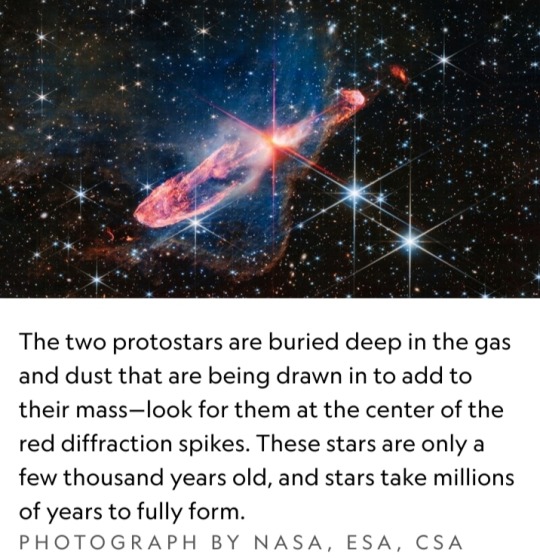
The hints pointing to two galaxies are found in the question mark’s strange shape.
There are two brighter spots, one in the curve and the other in the dot, which could be the galactic nuclei, or the centers of the galaxies, Britt says.
The curve of the question mark might be the “tails” being stripped off as the two galaxies spiral toward each other.
“It's very cute. It's a question mark … But you can find the colons and semicolons, and any other punctuation mark, because you have 10,000 little smudges of light in each image taken every half hour,” says David Helfand, an astronomer at Columbia University.
The sheer number of shining objects we find are bound to create some serendipitous images, and our brains have evolved to find those patterns, he says.
Astronomers have seen similar objects closer to home.
Two merging galaxies captured by the Hubble Space Telescope in 2008 also look like a question mark, just turned 90 degrees.
Helfand says the question mark seems to be two objects, the curve and the dot, but could be more that just happened to line up.
They could also be completely unrelated objects, he says, if one is much closer to Earth than the other.
Britt warns that estimating distance based only on colors in the image can be tricky.
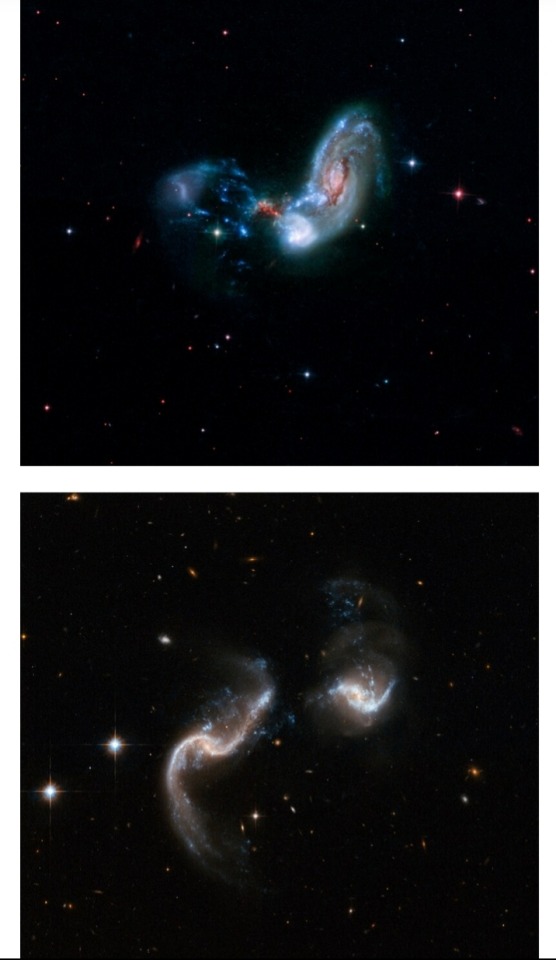
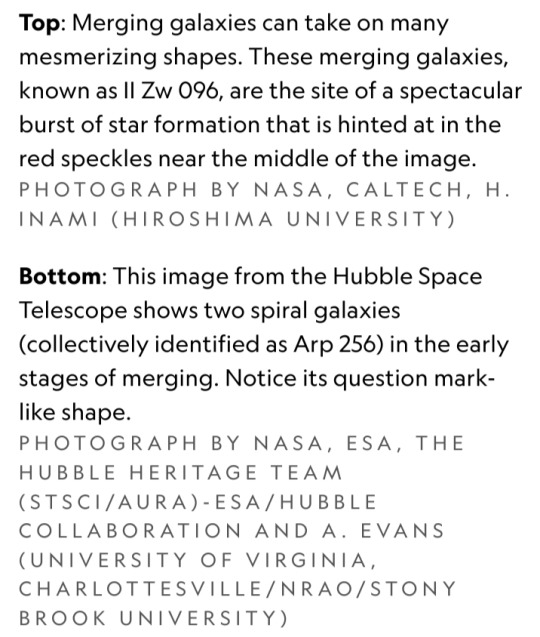
The red of the question mark could mean it’s very far away (light waves stretch as they travel through the expanding universe, shifting to redder wavelengths) or that it’s closer and obscured by dust near the object.
It would take more investigation to identify exactly how far away the question mark is.
This could be done by measuring photometric redshifts, determined by the brightness observed through different filters, but this would only provide an estimate for the distance, Britt says.
Spectroscopy, which analyzes light from the source to determine its elemental makeup, could provide a more exact distance but requires a separate instrument to measure.
Given the number of intriguing targets spotted by JWST, the question mark may never receive this treatment.
For now, the source of this symbol in the sky remains a cosmic mystery.
#James Webb Space Telescope (JWST)#celestial question mark#stars#galaxy#space#astronomy#Herbig-Haro 46/47#NIRCam#infrared light#protostars#Christopher Britt#Space Telescope Science Institute#galactic nuclei#astronomers#Hubble Space Telescope#photometric redshifts#Spectroscopy#cosmic mystery#National Geographic#Nat Geo#NASA
9 notes
·
View notes
Link
Space Nuts Episode: Gemstone Rain on Exoplanets and the Reliability of Research Papers #483 Join Andrew Dunkley and Professor Fred Watson as they explore the wonders of the cosmos in another intriguing episode of Space Nuts. This week, dive into the fascinating world of exoplanets with gemstone rain and discuss the reliability of research papers with insightful audience questions. Episode Highlights: - Gemstone Rain on Exoplanet WASP-121b: Discover the extraordinary exoplanet where it rains gemstones. Learn about the unique atmospheric conditions that lead to such exotic precipitation and the incredible journey of water and other materials across this tidally locked world. - Reliability of Research Papers: Delve into a thought-provoking discussion about the accuracy of scientific research papers. Explore how often published findings might be influenced by bias or statistical errors and what this means for fields like astronomy. - Space Debris in Kenya: Hear about the unexpected arrival of a massive metal object in a Kenyan village, identified as a separation ring from a rocket launch. Understand the implications of such events and the protocols followed under International Space Law. - Gravitational Wave Detection Breakthrough: Learn about a new technique called optical spring tracking that could significantly enhance our ability to detect gravitational waves. Discover how this advancement could provide insights into cosmic events from the earliest moments of the universe. For more Space Nuts, including our continually updating newsfeed and to listen to all our episodes, visit our website. Follow us on social media at SpaceNutsPod on Facebook, X, YouTube Music, YouTube Music Music, Tumblr, Instagram, and TikTok. We love engaging with our community, so be sure to drop us a message or comment on your favourite platform. For more Space and Astronomy News Podcasts, visit our HQ at www.bitesz.com. If you'd like to help support Space Nuts and join our growing family of insiders for commercial-free episodes and more, visit spacenutspodcast.com/about Stay curious, keep looking up, and join us next time for more stellar insights and cosmic wonders. Until then, clear skies and happy stargazing. 00:00 - This is Space Nuts, where we talk astronomy and space science 01:41 - Andrew Bennett: There's an exoplanet that rains gemstones 05:08 - You observe the star's light throughout the orbital period of the planet 12:09 - You can help support the Space Nuts podcast through Patreon or Supercast 13:47 - Bob from North Carolina has two questions for Professor Watson about scientific accuracy 22:12 - A metal object plummeted from space and landed in a Kenyan village on Tuesday 23:34 - Scientists have developed a new technique called optical spring tracking to detect gravitational waves ✍️ Episode References WASP-121b https://en.wikipedia.org/wiki/WASP-121b Massachusetts Institute of Technology (MIT) https://www.mit.edu/ Johns Hopkins University https://www.jhu.edu/ Caltech https://www.caltech.edu/ Hubble Space Telescope https://www.nasa.gov/mission_pages/hubble/main/index.html phys.org https://phys.org/ Astronomy Daily https://astronomydaily.io/ Advanced Laser Interferometer Gravitational-Wave Observatory (LIGO) https://www.ligo.caltech.edu/
#astronomical#astronomy#exoplanet#exploration#gemstone#gravitational#hubble#optical#rain#research#science#space#spectroscopy#spring#telescope#tracking#vapor#wasp-121b#water#waves
0 notes
Text

The James Webb Space Telescope is capable of producing detailed imagery of galaxies and stars throughout the universe. Astronomers, however, also rely on Webb’s ability to perform spectroscopy. Spectra spread light out into a range of colors to allow researchers to analyze the intensity (or brightness) of individual colors, or wavelengths. Each of Webb’s four instruments are capable of spectroscopy. There are six spectroscopy modes. Certain methods like single-object slitless or slit spectroscopy allow us to capture the spectra of individual bright objects or small, but bright regions. Other methods take the spectra of many objects or an entire field, like in wide-field slitless or multi-object spectroscopy. See each of Webb’s spectroscopy modes and which instruments are involved for each: https://webbtelescope.pub/3uJUKoW
#space#astronomy#stsci#science#nasa#universe#nasawebb#james webb space telescope#jwst#webb telescope#webb#webb instruments#spectroscopy
58 notes
·
View notes
Text
Using the James Webb Space Telescope (JWST), astronomers from the Space Telescope Science Institute (STScI) in Baltimore, Maryland and elsewhere have conducted transmission spectroscopy of a nearby super-Earth exoplanet known as L98-59 d. Results of these observations, available in a research paper published August 28 on the pre-print server arXiv, suggest that the planet has a sulfur-rich atmosphere. L98-59 is a bright M-dwarf star located some 34.6 light years away. It is known to be orbited by at least four planets, and one of them is L98-59 d—a super-Earth about 58% larger than the Earth, with a mass of 2.31 Earth masses. L98-59 d orbits its host every 7.45 days, at a distance of approximately 0.05 AU. The planet's equilibrium temperature is estimated to be 416 K.
Continue Reading.
49 notes
·
View notes
Text

Roaming the Mineral-Rich Southern Lunar Terrain // Alien_Enthusiast
Read below the cut for some info about which craters are featured and a map to help identify them!
In birth order of their eponyms:
Purbach crater is named after Austrian astronomer Georg von Peuerbach (1423-1461) who aimed at making astronomy accessible for the average European during the Renaissance with his textbook, Theoricae Novae Planetarum.
Walther crater is named after the German merchant Bernhard Walther (1430-1504) who was a noted observer of the motions of the planets.
Regiomontanus crater is named after German mathematician Johannes Müller von Königsberg (1436-1476) who helped develop the heliocentric theory of the solar system with trigonometry.
Orontius crater is named after the French mathematician Oronce Finé (1494-1555) who published an astronomy textbook De mundi sphaera which guided readers on the use of equipment and proper astronomy methods.
Nonius crater is named for Pedro Nunes (1502-1578), a Portuguese mathematician who used trigonometry to make improvements to the geocentric model of the solar system.
Hell crater is not named after the land of Satan, but instead is named after Hungarian astronomer Maximilian Hell (1720-1792) who was the director of the Vienna Observatory and observed the 1769 transit of Venus.
Lexell crater is named after the Finnish astronomer Andres Johan Lexell (1740-1784), a prolific member of the Russian Academy of Sciences who made important discoveries in celestial mechanics. He was the first to prove that Uranus was a planet rather than a comet.
Miller crater is named after William Allen Miller (1817-1870), a British chemist who aided William Huggins in studying the spectra of astronomical objects, primarily stars.
Huggins crater is named after the British astronomer William Huggins (1824-1910) who pioneered the realm of astronomical spectroscopy, becoming the first to take the spectrum of a planetary nebula.
Bell crater is named after none other than Canadian inventor Alexander Graham Bell (1847-1922) most famous for inventing the telephone, but who also had inventions in aeronautics.
Deslandres crater is named for Henri Alexandre Deslandres (1853-1948), a French astronomer who was the director of the Paris Observatories and carried out studies on the atmosphere of the Sun.

#astronomy#astrophotography#solar system#moon#the moon#luna#lunar surface#crater#lunar crater#history#etymology#nonius#miller#huggins#orontius#walther#lexell#deslandres#hell#bell#regiomontanus#purbach
36 notes
·
View notes
Text
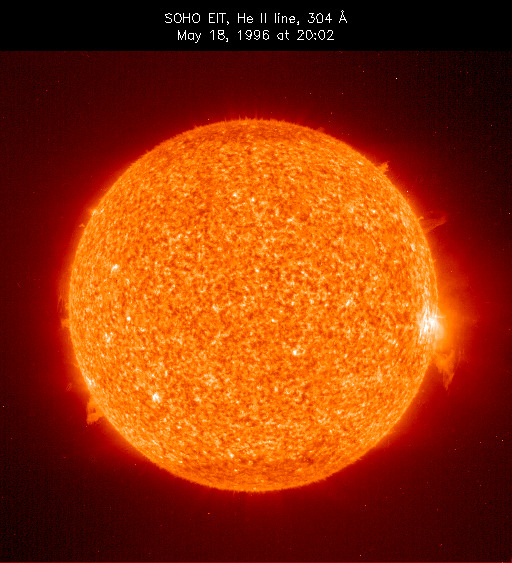
Helios Helium - May 20th, 1996.
"Above is an image of the relatively quiet Sun made on May 18th, 1996, in light emitted by ionised helium atoms in the Solar chromosphere. Helium was first discovered in the Sun in 1868, its name fittingly derived from the Greek word Helios, meaning Sun. Credit for the discovery goes to astronomer Joseph Lockyer. Lockyer relied on a developed technique of spectroscopy, dissecting sunlight into a spectrum, and the idea that each element produces a characteristic spectral pattern of bright lines. He noticed a yellow line in a solar spectrum made during an eclipse which could not be accounted for by elements known on Earth. Almost 27 years later, helium was finally discovered on Earth when the spectrum of a helium bearing mineral of uranium provided an exact match to the previously detected element of the Sun. Helium is now known to be the second most abundant element (after hydrogen) in the Universe."
46 notes
·
View notes
Text


GALACTIC BULLSEYE
W. M. Keck Observatory on Maunakea, Hawaiʻi Island and NASA’s Hubble Space Telescope have captured a cosmic bullseye! The gargantuan galaxy LEDA 1313424 is rippling with nine star-filled rings after an “arrow” — a far smaller blue dwarf galaxy — shot through its heart.
Astronomers using Hubble identified eight visible rings, more than previously detected by any telescope in any galaxy and confirmed a ninth ring using data from the Keck Cosmic Web Imager (KCWI) at Keck Observatory. Previous observations of other galaxies show a maximum of two or three rings.
The study, led by Yale University, is published in today’s issue of The Astrophysical Journal Letters.
“This was a serendipitous discovery,” said Imad Pasha, the lead researcher and a doctoral student at Yale University in New Haven, Connecticut. “I was looking at a ground-based imaging survey and when I saw a galaxy with several clear rings, I was immediately drawn to it. I had to stop to investigate it.” The team later nicknamed the galaxy the “Bullseye.”
Keck Observatory and Hubble’s follow-up observations helped the researchers prove which galaxy plunged through the center of the Bullseye — a blue dwarf galaxy to its center-left. This relatively tiny interloper traveled like a dart through the core of the Bullseye about 50 million years ago, leaving rings in its wake like ripples in a pond. A thin trail of gas now links the pair, though they are currently separated by 130,000 light-years.
“We’re catching the Bullseye at a very special moment in time,” said Pieter G. van Dokkum, a co-author and a professor at Yale. “There’s a very narrow window after the impact when a galaxy like this would have so many rings.”
Galaxies collide or barely miss one another quite frequently on cosmic timescales, but it is extremely rare for one galaxy to dive through the center of another. The blue dwarf galaxy’s straight trajectory through the Bullseye later caused material to move both inward and outward in waves, setting off new regions of star formation.
“KCWI provided the critical view of this companion galaxy that we see in projection near the bullseye,” said Pasha. “We found a clear signature of gas extending between the two systems, which allowed us to confirm that this galaxy is in fact the one that flew through the center and produced these rings.”
How big is the Bullseye? Our Milky Way galaxy is about 100,000 light-years in diameter, and the Bullseye is almost two-and-a-half times larger, at 250,000 light-years across.
The researchers used Hubble’s crisp vision to carefully pinpoint the location of most of its rings, since many are piled up at the center, and used Keck Observatory’s KCWI to confirm the existence of the ninth ring. The team suspects a tenth ring also existed but has faded and is no longer detectable. They estimate it might lie three times farther out than the widest ring in Hubble’s image.
There’s a lot more research to be done to figure out which stars existed before and after the blue dwarf’s “fly through.” Astronomers will now also be able to improve models showing how the galaxy may continue to evolve over billions of years, including the disappearance of additional rings.
“The data from KCWI that identified the ‘dart’ or impactor is unique,” van Dokkum said. “There hasn’t been any other case where you can so clearly see the gas streaming from one galaxy to the other. That there is all this gas right between the velocity of one galaxy and the other is the key insight, showing that material is being pulled out of one galaxy, left behind by the other, or both. It physically fills up the entire space. The KCWI data enables us to see the tendril of gas that is still connecting these two galaxies.”
ABOUT KCWI
The Keck Cosmic Web Imager (KCWI) is designed to provide visible band, integral field spectroscopy with moderate to high spectral resolution formats and excellent sky-subtraction. The astronomical seeing and large aperture of the telescope enables studies of the connection between galaxies and the gas in their dark matter halos, stellar relics, star clusters, and lensed galaxies. KCWI covers the blue side of the visible spectrum; the instrument also features the Keck Cosmic Reionization Mapper (KCRM), extending KCWI’s coverage to the red side of the visible spectrum. The combination of KCWI-blue and KCRM provides simultaneous high-efficiency spectral coverage across the entire visible spectrum. Support for KCWI was provided by the National Science Foundation, Heising-Simons Foundation, and Mt. Cuba Astronomical Foundation. Support for KCRM was provided by the National Science Foundation and Mt. Cuba Astronomical Foundation.
ABOUT W. M. KECK OBSERVATORY
The W. M. Keck Observatory telescopes are among the most scientifically productive on Earth. The two 10-meter optical/infrared telescopes atop Maunakea on the Island of Hawaii feature a suite of advanced instruments including imagers, multi-object spectrographs, high-resolution spectrographs, integral-field spectrometers, and world-leading laser guide star adaptive optics systems. Some of the data presented herein were obtained at Keck Observatory, which is a private 501(c) 3 non-profit organization operated as a scientific partnership among the California Institute of Technology, the University of California, and the National Aeronautics and Space Administration. The Observatory was made possible by the generous financial support of the W. M. Keck Foundation. The authors wish to recognize and acknowledge the very significant cultural role and reverence that the summit of Maunakea has always had within the Native Hawaiian community. We are most fortunate to have the opportunity to conduct observations from this mountain. For more information, visit:www.keckobservatory.org
UPPER IMAGE: NASA’s Hubble Space Telescope image of Galaxy LEDA 1313424, aptly nicknamed the Bullseye, is two and a half times the size of our Milky Way and has nine rings — six more than any other known galaxy. High-resolution imagery from Hubble confirmed eight rings, and data from the W. M. Keck Observatory in Hawaiʻi confirmed a ninth. Hubble and Keck Observatory also confirmed which galaxy dove through the Bullseye, creating these rings: the blue dwarf galaxy that sits to its immediate left. Credit: NASA, ESA, Imad Pasha (Yale University), Pieter G. van Dokkum (Yale University).
LOWER IMAGE: This illustration compares the size of our own Milky Way galaxy to gargantuan galaxy LEDA 1313424, nicknamed the Bullseye. The Milky Way is about 100,000 light-years in diameter, and the Bullseye is almost two-and-a-half times larger, at 250,000 light-years across. Credit: NASA, ESA, Ralf Crawford (STScI).

9 notes
·
View notes
Text
at some point the k218b dimethyl sulfide paper is going to get published and every astronomer in the world is going to slew in your direction like "oh so you finally heard about that" and then they will pull out a folder of outreach curricula on spectroscopy and dimethyl sulfide formation pathways that they've been preparing for the past couple years. so watch out for that
35 notes
·
View notes
Text
Eta Carinae
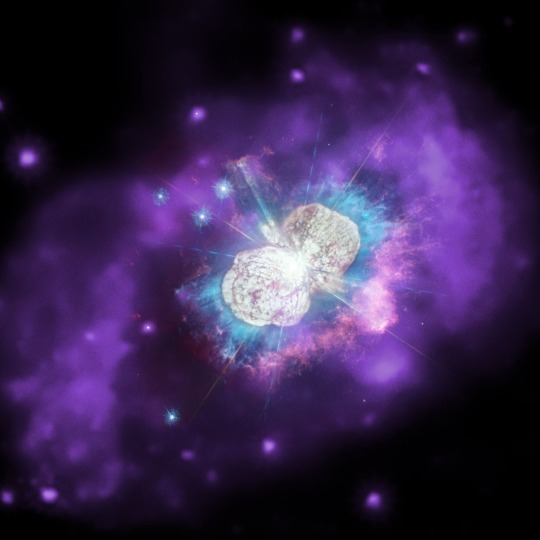
Eta Carinae: A Stellar Beauty
In the vast expense of our universe, where stars twinkle like celestial gems, there lies a dazzling beauty named Eta Carinae. Prepare to be captivated as I take you on a journey to discover the secrets of this cosmic wonder.
Eta Carinae, known lovingly as “Eta” by astronomers, is a stellar masterpiece in the Carina Nebula, approximately 7.500 light-years away from Earth. This stellar gem has captivated astronomers for centuries with its majestic presence and intriguing nature.
A Star Like No Other
Eta Carinae is not your ordinary star-it’s a binary star system consisting of two massive, luminous stars locked in an intricate cosmic dance. These stars Eta Carinae A and Eta Carinae B -creative names, I know- are classified as hypergiants, making them some of the most massive and brightest stars. (that we know of)
Historic Outbursts

Since then, Eta Carinae has experienced smaller-scale eruptions, displaying irregular brightness variations and releasing enormous amounts of energy.
Impending Supernova:
One of the most captivating aspects of Eta Carinae is the potential for a future supernova event. The massive star is nearing the end of its life, and astronomers anticipate that it will eventually explode in a spectacular supernova. When this cataclysmic event occurs, it is expected to release an immense amount of energy, briefly outshining its host galaxy. The timing of this explosion remains uncertain, adding to the intrigue and urgency of studying Eta Carinae.
Understanding the Phenomenon:
The erratic behavior and imminent explosion of Eta Carinae pose intriguing questions for scientists. Studying this stellar system provides valuable insights into the evolution and fate of massive stars. Astronomers employ various observational techniques, including spectroscopy, imaging, and monitoring of brightness fluctuations, to unravel the physical processes at play within Eta Carinae. By analyzing the data collected over decades, researchers hope to decipher the mechanisms driving its eruptions and better predict the timing of its impending supernova.
Implications for the Universe:
Eta Carinae's significance extends beyond its individuality. Massive stars like Eta Carinae play a pivotal role in shaping galaxies and enriching the cosmos with heavy elements. Supernova explosions from such stars distribute these elements throughout the universe, ultimately contributing to the formation of new stars, planets, and even life. Understanding the life cycle of massive stars through the study of objects like Eta Carinae enhances our knowledge of cosmic evolution on a grand scale.
14 notes
·
View notes
Text

"I had no role models because nobody ever publicized them, not that they didn't exist. George Washington Carver and Percy Julian and others had preceded me in science, but nobody ever publicized their accomplishments, and, therefore, many of the minority students didn't know that they had a future in science because they figured it was something that was not for them."
After a bit of time away from this project to make room for convention appearances and other shows, I now return to the subject with a look at the life and accomplishments of physicist George Robert Carruthers, on this, what would have been his 85th birthday.
Born in 1939 Cincinnati, Carruthers's father was himself a civil engineer at Wright-Patterson AFB, but the family soon moved to the more rural location of Milford, Ohio. Carruthers was described as quiet and focused --intensely interested in space travel stories and comic books (my people!), and a devourer of the science articles in Collier's magazine (even penning a fan letter to Dr. Werner Von Braun, to which he received an unexpected and encouraging personal reply). At the age of ten Carruthers built his first telescope, constructed from lenses he obtained by mail order. After George's father died in 1952, the family moved to Chicago but his fascination with spaceflight did not diminish. Encouraged by wonderfully observant teachers, he eventually graduated from the University of Illinois, Urbana-Champaign in 1960, then earned his MS in in nuclear engineering in 1962, and then landed his PhD in aeronautical and astronautical engineering in 1964.
While working towards his PhD, Carruthers worked as a researcher and teaching assistant, studying plasma and gases. In 1964, Carruthers took a postdoctoral appointment with the Naval Research Laboratory (NRL) in Washington, D.C., focusing on far ultraviolet astronomy. In 1969 he received a U.S. patent for inventing a form of image converter; an instrument that detects electromagnetic radiation in short wavelengths. In 1970 his invention recorded the first observation of molecular hydrogen in outer space (which he described as "a very big deal at the time.")
Far and away (literally), Dr. Carruthers's greatest contribution to science is his development and construction of an ultraviolet electronographic telescope, which became the first (and to date still the only) astronomical instrument sent to the surface of the Moon; more properly known as the Far Ultraviolet Camera/Spectrograph. The camera was brought along on the Apollo 16 mission in 1972, set up to observe the Earth's geocorona (outermost atmosphere) from a vantage point never before possible. A short time later a variation on this very same camera was brought aboard Skylab to photograph the near approach of Comet Kohoutek, the first instance of a comet being recorded in ultraviolet. A flight backup of the Apollo 16 instrument, along with the original mission film canister, stood for many years as part of the lunar lander exhibit at the National Air & Space Museum, until it was later transferred to a more protected exhibit to guard against corrosion.
Dr. Carruthers's success and notoriety from the Apollo mission led to his creation of the Science & Engineers Apprentice Program, offering disadvantaged high school students the opportunity to work with scientists at the Naval Research Laboratory. His research into ultraviolet spectroscopy continued --in 1991 one of his ultraviolet cameras was used in multiple experiments aboard the Space Shuttle Discovery (STS-39). He retired from the NRL in 2002 and in 2003, was inducted into the National Inventor Hall of Fame. In 2013 was awarded the National Medal for Technology and Innovation by President Barack Obama. Dr. Carruthers died on Christmas Day, 2020.
8 notes
·
View notes
Text
IS QUASAR A BLACK HOLE??
Blog#289
Wednesday, April 19th, 2023
Welcome back,
A quasar is a supermassive black hole feeding on gas at the center of a distant galaxy.
Quasar is short for quasi-stellar radio source, because astronomers first discovered quasars in 1963 as objects that looked like stars but emitted radio waves.
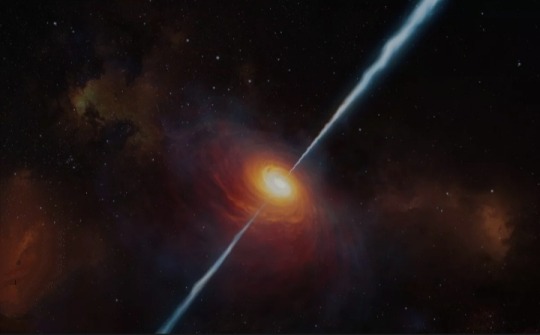
Now, the term is a catch-all for all feeding, and therefore luminous supermassive black holes, also often called active galactic nuclei.
It’s a bit of a contradiction to call a black hole luminous; black holes themselves are, of course, black. In fact, almost every large galaxy hosts a black hole with the mass of millions to billions of Suns, and many of these black holes lurk in the dark. Our Milky Way’s behemoth weighs in at 4.3 million solar masses, but its starvation diet mutes all but faint flashes and flickers.
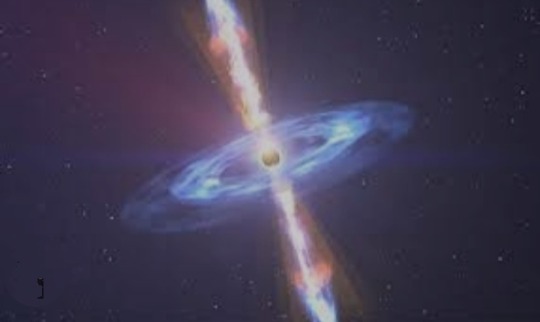
We know it’s there, though, from the orbits of stars around it. Other dormant black holes occasionally shred an infalling star, making their presence known by the flare of radiation that ensues.
But quasars are a different breed of black hole. They reside in galaxies with plentiful gas supplies, perhaps supplied by a recent galaxy-galaxy collision, and they gorge on the inflowing material.
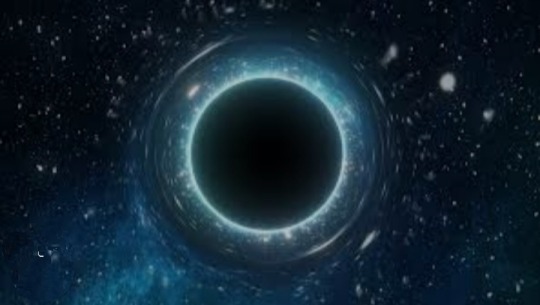
The gas spirals around as it falls in, heating up in the process and emitting radiation across the electromagnetic spectrum.
Supermassive black holes in nearby galaxies typically do not have that much gas available to them, so quasars are typically found in distant galaxies. The nearest quasar is Markarian 231, which lies about 600 million light-years from Earth.
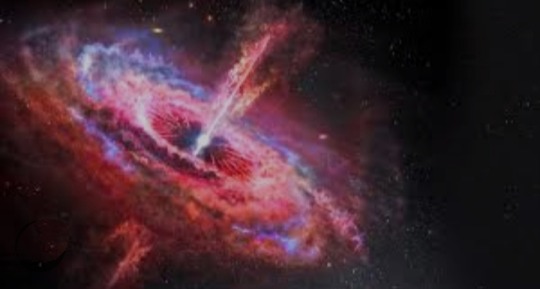
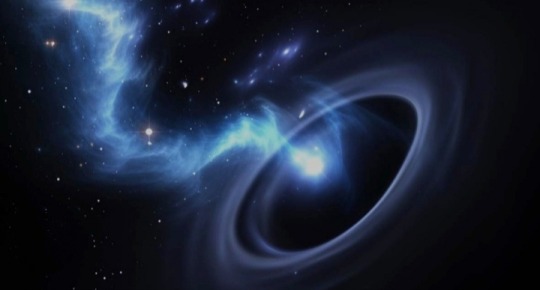
A quasar is not only the feeding black hole itself, but the light-producing structures that surround it. Visible and ultraviolet light come from the glowing disk of infalling material, while even hotter gas above the disk shines at X-ray energies. Jets shooting out along the black hole’s poles emit everything from radio waves to X-rays. Farther out from the black hole, the prolific dust and gas glow at infrared wavelengths.
The size of a quasar accretion disk, which scales with the mass of its black hole, is typically a few light-days across. That dwarfs in comparison to its host galaxy; the Milky Way for comparison is roughly 100,000 light-years across. Yet quasars often outshine their hosts.
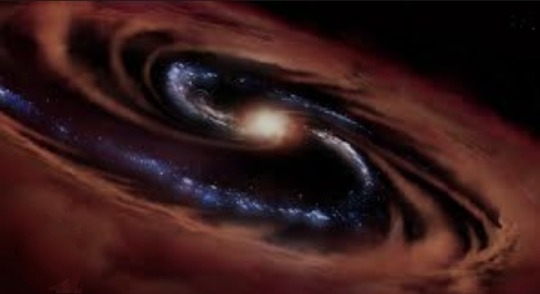
Despite their brilliance, quasars are so small and distant that even the most powerful telescope cannot resolve all the structures within a quasar.
Astronomers have to ferret out the details using other techniques, such as analyzing spectroscopy (spreading out the light by wavelength) or light curves (spreading out the light by its arrival time).
While the details are still up for debate, we can use current knowledge to paint a general picture of a quasar. Just remember that this picture might change over time as we learn more!
Originally published on skyandtelescope.org
COMING UP!!
(Saturday, April 22nd, 2023)
"HOW LONG DO BLACK HOLES LAST??"
#astronomy#outer space#alternate universe#astrophysics#spacecraft#universe#white universe#space#parallel universe#astrophotography
85 notes
·
View notes
Text
Black Scientists and Engineers Past and Present Enable NASA Space Telescope
The Nancy Grace Roman Space Telescope is NASA’s next flagship astrophysics mission, set to launch by May 2027. We’re currently integrating parts of the spacecraft in the NASA Goddard Space Flight Center clean room.
Once Roman launches, it will allow astronomers to observe the universe like never before. In celebration of Black History Month, let’s get to know some Black scientists and engineers, past and present, whose contributions will allow Roman to make history.

Dr. Beth Brown
The late Dr. Beth Brown worked at NASA Goddard as an astrophysicist. in 1998, Dr. Brown became the first Black American woman to earn a Ph.D. in astronomy at the University of Michigan. While at Goddard, Dr. Brown used data from two NASA X-ray missions – ROSAT (the ROentgen SATellite) and the Chandra X-ray Observatory – to study elliptical galaxies that she believed contained supermassive black holes.
With Roman’s wide field of view and fast survey speeds, astronomers will be able to expand the search for black holes that wander the galaxy without anything nearby to clue us into their presence.

Dr. Harvey Washington Banks
In 1961, Dr. Harvey Washington Banks was the first Black American to graduate with a doctorate in astronomy. His research was on spectroscopy, the study of how light and matter interact, and his research helped advance our knowledge of the field. Roman will use spectroscopy to explore how dark energy is speeding up the universe's expansion.
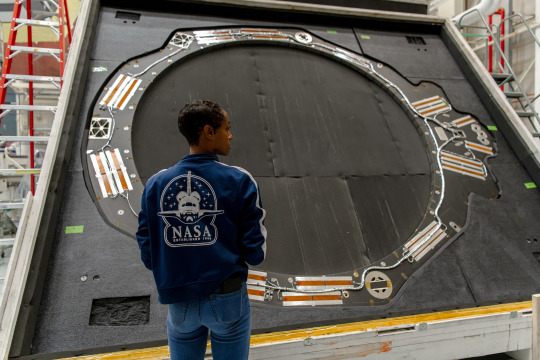
NOTE - Sensitive technical details have been digitally obscured in this photograph.
Sheri Thorn
Aerospace engineer Sheri Thorn is ensuring Roman’s primary mirror will be protected from the Sun so we can capture the best images of deep space. Thorn works on the Deployable Aperture Cover, a large, soft shade known as a space blanket. It will be mounted to the top of the telescope in the stowed position and then deployed after launch. Thorn helped in the design phase and is now working on building the flight hardware before it goes to environmental testing and is integrated to the spacecraft.

Sanetra Bailey
Roman will be orbiting a million miles away at the second Lagrange point, or L2. Staying updated on the telescope's status and health will be an integral part of keeping the mission running. Electronics engineer Sanetra Bailey is the person who is making sure that will happen. Bailey works on circuits that will act like the brains of the spacecraft, telling it how and where to move and relaying information about its status back down to Earth.
Learn more about Sanetra Bailey and her journey to NASA.

Dr. Gregory Mosby
Roman’s field of view will be at least 100 times larger than the Hubble Space Telescope's, even though the primary mirrors are the same size. What gives Roman the larger field of view are its 18 detectors. Dr. Gregory Mosby is one of the detector scientists on the Roman mission who helped select the flight detectors that will be our “eyes” to the universe.
Dr. Beth Brown, Dr. Harvey Washington Banks, Sheri Thorn, Sanetra Bailey, and Dr. Greg Mosby are just some of the many Black scientists and engineers in astrophysics who have and continue to pave the way for others in the field. The Roman Space Telescope team promises to continue to highlight those who came before us and those who are here now to truly appreciate the amazing science to come.
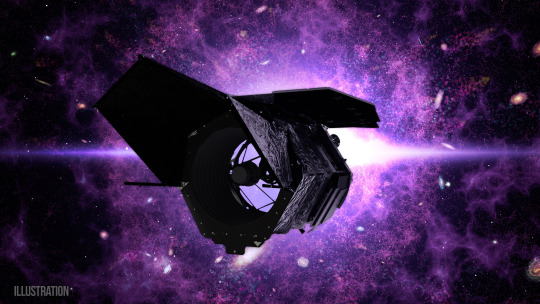
To stay up to date on the mission, check out our website and follow Roman on X and Facebook.
Make sure to follow us on Tumblr for your regular dose of space!
#NASA#astronomy#telescope#Roman Space Telescope#galaxies#black holes#space tech#astrophysics#spectroscopy#STEM#engineering#Black History Month#BlackExcellence365#science#tech#technology
2K notes
·
View notes
Video
tumblr
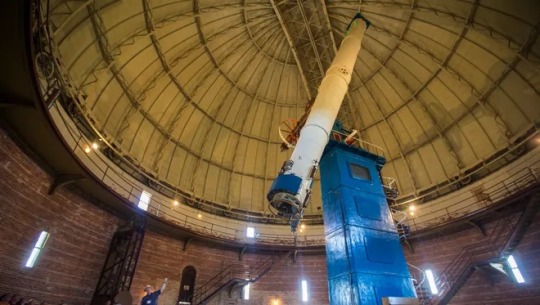


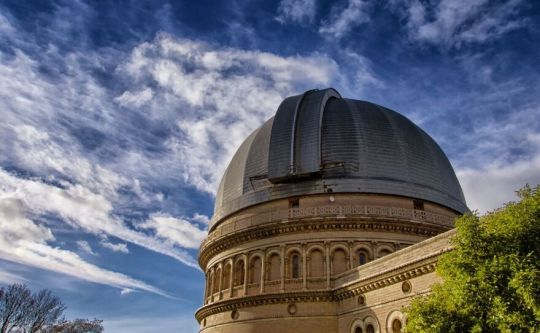
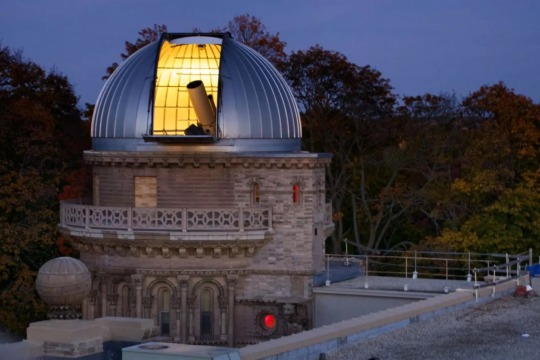
Yerkes Observatory
Yerkes Observatory, astronomical observatory located at Williams Bay on Lake Geneva in southeastern Wisconsin, U.S. The Yerkes Observatory of the University of Chicago was named for its benefactor, transportation magnate Charles T. Yerkes, and was opened in 1897. It contains the largest refracting telescope (40 inches [1 metre]) in the world. The refractor has been used for solar and stellar spectroscopy, photographic parallaxes, and double-star observations, while other more modern telescopes at the site have been equipped for photoelectric, polarimetric, and spectroscopic applications.
#Yerkes Observatory#astronomical observatory#telescope#the worlds largest refracting telescope#space#science#astronomy#astronomer
75 notes
·
View notes
Text


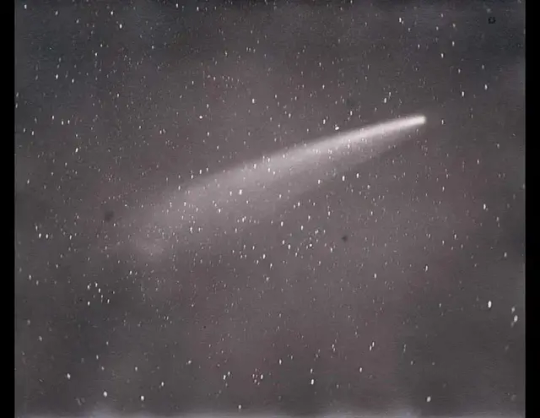
On 12th June 1843 Sir David Gill, Scottish astronomer, was born in Aberdeen.
At the age of fourteen he was sent to the Dollar Academy, where Dr. Lindsay's teaching imparted to him a fondness for mathematics, physics, and chemistry. He then proceeded to Marischal College and University, Aberdeen, where his love of science increased and developed under the inspiring influence of Clerk Maxwell. He would have liked a scientific career, but his father, a prosperous Aberdeen merchant, wished his son to succeed him. Gill consented with reluctance to enter his father's business, and consoled himself by devoting all his spare time to physics and chemistry, at least until his father's passing, after a few years he sold the business
Gill was noted for his measurements of solar and stellar parallaxes, which accurately revealed the distances of the Sun and other stars to Earth. He was also a pioneer in the use of photography to map the heavens.
His measurements to the sun were only a mind boggling 0.1% of today's calculations! He is quite simply the most important astronomer you've never heard.
David Gill’s contributions to astronomy made him one of the most successful astronomers of his era, a time covering the last quarter of the 19th century and into the 20th century. This was a time when astrometrics came of age, astrophotography began to transform astronomy, stellar spectroscopy became a technique that all professional observatories needed to embrace and international, multi-observatory projects were shown to be the way forward into the 20th century. David Gill played a seminal part in all these developments. His achievements were recognised in his lifetime both at home, and abroad but as happens with many who promote an era of change, it has been the achievements of those who succeeded him when the techniques matured who are better remembered. David Gill was much more.
Much more on Gill on the link below.
5 notes
·
View notes
Text


6 Things to Know About SPHEREx, NASA’s Newest Space Telescope
Shaped like a megaphone, the upcoming mission will map the entire sky in infrared light to answer big questions about the universe.
Expected to launch no earlier than Thursday, Feb. 27, from Vandenberg Space Force Base in California, NASA’s SPHEREx space observatory will provide astronomers with a big-picture view of the cosmos like none before. Short for Spectro-Photometer for the History of the Universe, Epoch of Reionization and Ices Explorer, SPHEREx will map the entire celestial sky in 102 infrared colors, illuminating the origins of our universe, galaxies within it, and life’s key ingredients in our own galaxy. Here are six things to know about the mission.
1. The SPHEREx space telescope will shed light on a cosmic phenomenon called inflation.
In the first billionth of a trillionth of a trillionth of a second after the big bang, the universe increased in size by a trillion-trillionfold. Called inflation, this nearly instantaneous event took place almost 14 billion years ago, and its effects can be found today in the large-scale distribution of matter in the universe. By mapping the distribution of more than 450 million galaxies, SPHEREx will help scientists improve our understanding of the physics behind this extreme cosmic event.
2. The observatory will measure the collective glow from galaxies near and far.
Scientists have tried to estimate the total light output from all galaxies throughout cosmic history by observing individual galaxies and extrapolating to the trillions of galaxies in the universe. The SPHEREx space telescope will take a different approach and measure the total glow from all galaxies, including galaxies too small, too diffuse, or too distant for other telescopes to easily detect. Combining the measurement of this overall glow with other telescopes’ studies of individual galaxies will give scientists a more complete picture of all the major sources of light in the universe.
3. The mission will search the Milky Way galaxy for essential building blocks of life.
Life as we know it wouldn’t exist without basic ingredients such as water and carbon dioxide. The SPHEREx observatory is designed to find these molecules frozen in interstellar clouds of gas and dust, where stars and planets form. The mission will pinpoint the location and abundance of these icy compounds in our galaxy, giving researchers a better sense of their availability in the raw materials for newly forming planets.
4. It adds unique strengths to NASA’s fleet of space telescopes.
Space telescopes like NASA’s Hubble and Webb have zoomed in on many corners of the universe to show us planets, stars, and galaxies in high resolution. But some questions — like how much light do all the galaxies in the universe collectively emit? — can be answered only by looking at the big picture. To that end, the SPHEREx observatory will provide maps that encompass the entire sky. Objects of scientific interest identified by SPHEREx can then be studied in more detail by targeted telescopes like Hubble and Webb.
5. The SPHEREx observatory will make the most colorful all-sky map ever.
The SPHEREx observatory “sees” infrared light. Undetectable to the human eye, this range of wavelengths is ideal for studying stars and galaxies. Using a technique called spectroscopy, the telescope can split the light into its component colors (individual wavelengths), like a prism creates a rainbow from sunlight, in order to measure the distance to cosmic objects and learn about their composition. With SPHEREx’s spectroscopic map in hand, scientists will be able to detect evidence of chemical compounds, like water ice, in our galaxy. They’ll not only measure the total amount of light emitted by galaxies in our universe, but also discern how bright that total glow was at different points in cosmic history. And they’ll chart the 3D locations of hundreds of millions of galaxies to study how inflation influenced the large-scale structure of the universe today.
6. The spacecraft’s cone-shaped design helps it stay cold and see faint objects.
The mission’s infrared telescope and detectors need to operate at around minus 350 degrees Fahrenheit (about minus 210 degrees Celsius). This is partly to prevent them from generating their own infrared glow, which might overwhelm the faint light from cosmic sources. To keep things cold while also simplifying the spacecraft’s design and operational needs, SPHEREx relies on an entirely passive cooling system — no electricity or coolants are used during normal operations. Key to making this feat possible are three cone-shaped photon shields that protect the telescope from the heat of Earth and the Sun, as well as a mirrored structure beneath the shields to direct heat from the instrument out into space. Those photon shields give the spacecraft its distinctive outline.
More About SPHEREx
SPHEREx is managed by NASA’s Jet Propulsion Laboratory for the agency’s Astrophysics Division within the Science Mission Directorate at NASA Headquarters in Washington. BAE Systems (formerly Ball Aerospace) built the telescope and the spacecraft bus. The science analysis of the SPHEREx data will be conducted by a team of scientists located at 10 institutions in the U.S., two in South Korea, and one in Taiwan. Data will be processed and archived at IPAC at Caltech, which manages JPL for NASA. The mission principal investigator is based at Caltech with a joint JPL appointment. The SPHEREx dataset will be publicly available at the NASA/IPAC Infrared Science Archive.
TOP IMAGE: NASA’s SPHEREx observatory undergoes testing at BAE Systems in Boulder, Colorado, in August 2024. Launching no earlier than Feb. 27, 2025, the mission will make the first all-sky spectroscopic survey in the near-infrared, helping to answer some of the biggest questions in astrophysics. Credit: BAE Systems/NASA/JPL-Caltech
LOWER IMAGE: Molecular clouds like this one, called Rho Ophiuchi, are collections of cold gas and dust in space where stars and planets can form. SPHEREx will survey such regions throughout the Milky Way galaxy to measure the abundance of water ice and other frozen molecules. Credit: NASA/JPL-Caltech
6 notes
·
View notes